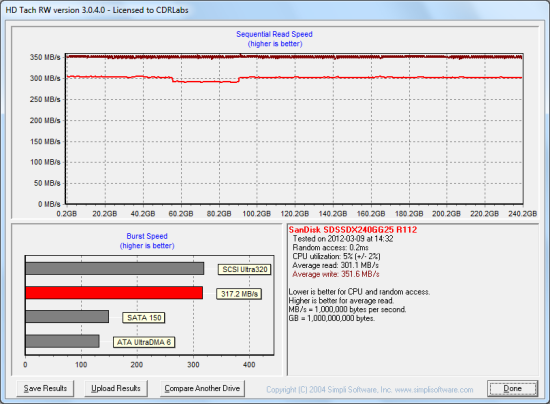TRIM Performance:
While SSDs offer many benefits, there are some downsides to using flash memory. One of the biggest issues people run into is performance degradation. Over time, an SSD will run out of fresh blocks and will have to write over data the file system has marked as deleted. This procedure is very complicated and can slow an SSD's write speeds considerably.
To address this problem, most manufacturers have added TRIM support to their SSDs. The TRIM command allows an operating system, such as Windows 7, to tell an SSD which data blocks are no longer in use. Using this information, the drive pro-actively erases these blocks and adds them to the free block pool.

To test the Extreme's TRIM function, I first put the drive in a "dirty" state. I used Iometer to fill the entire drive and then ran a random write test for 30 minutes. This had very little effect on the Extreme's write speed. However, its average read speed dropped to 203.8 MB/s.

SanDisk Extreme SSD - Dirty
To see how well the Extreme could recover, I let the computer sit for a few hours and then reran the test. The drive wasn't able to reach the factory fresh performance shown in our earlier tests. However, its average read speed climbed up to 301.1 MB/s.

SanDisk Extreme SSD - After Trim
Lastly, I used Parted Magic to perform a secure erase on the Extreme. With the drive wiped clean, its read speed jumped back up to 365.8 MB/s.

SanDisk Extreme SSD - Wiped
Final Thoughts:
With the Extreme, SanDisk has made its long awaited entrance into the high-performance SSD market. Targeted at gamers and enthusiasts, this new SSD combines LSI's SandForce SF-2281 controller with the company's own 24nm MLC Toggle Mode NAND flash to deliver some truly impressive performance. In our sequential read and write tests, the Extreme was able to read at speeds as high as 555 MB/s and write at speeds in excess of 475 MB/s. It also took the top spot in our random write tests, producing more than 75,000 IOPS. As with other SandForce drives, the Extreme's performance did take a hit when reading and writing incompressible data. However, thanks to its Toggle Mode NAND flash, its performance didn't suffer nearly as much as some other drives.
The SanDisk Extreme SSD is available now in 120GB and 240GB capacities and a 480GB version is coming later this year. The 120GB drive currently retails for about $150 with the 240GB version reviewed here going for less than $330 on Amazon.

Highs:
- Available in 120GB, 240GB and 480GB capacities
- SandForce SF-2281 processor with DuraClass, DuraWrite and RAISE technologies
- Excellent sequential read and write speeds
- SATA 6Gb/s interface
- Toggle Mode NAND flash
- Supports TRIM, SMART and NCQ
- Well constructed
- Reasonably priced
- 3 year warranty
Lows:
- Does not include a 2.5" to 3.5" adapter bracket
- Not as fast when writing incompressible data

